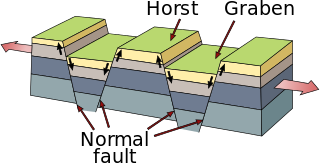Horst_and_graben
Horst and graben
Topography consisting of alternating raised and lowered fault blocks
In geology, horst and graben (or range and valley) refers to topography consisting of alternating raised and lowered fault blocks known as horsts and grabens. The features are created by normal faulting and rifting caused by crustal extension.[1] Horst and graben are formed when normal faults of opposite dip occur in pairs with parallel strike, and are always formed together. Each feature can range in size from a few centimeters up to tens of kilometers, and the vertical displacement can be up to several thousand meters. The movement on either side of each block is typically equal, resulting in little tilting.[2]
This article needs additional citations for verification. (November 2018) |
